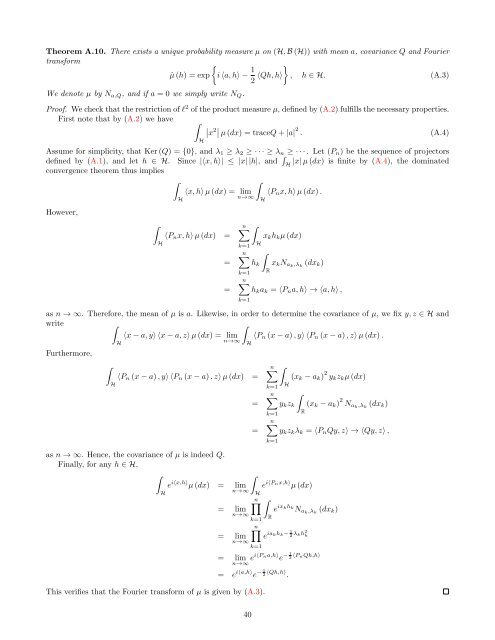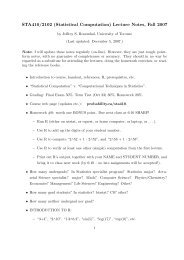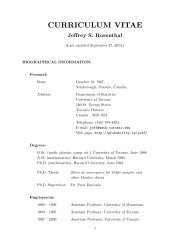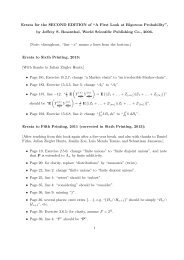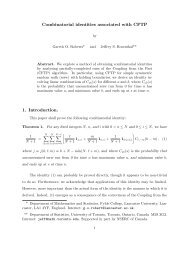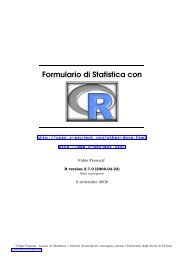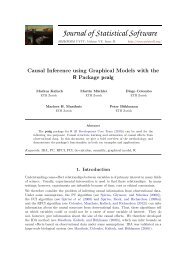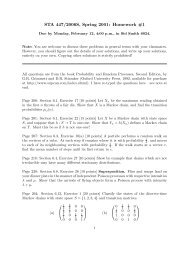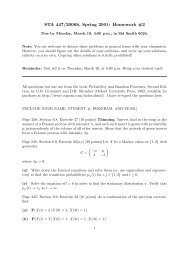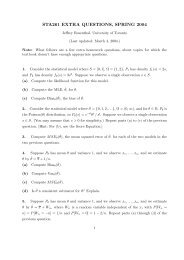final report - probability.ca
final report - probability.ca
final report - probability.ca
You also want an ePaper? Increase the reach of your titles
YUMPU automatically turns print PDFs into web optimized ePapers that Google loves.
Theorem A.10. There exists a unique <strong>probability</strong> measure µ on (H, B (H)) with mean a, covariance Q and Fourier<br />
transform<br />
ˆµ (h) = exp<br />
{i 〈a, h〉 − 1 }<br />
2 〈Qh, h〉 , h ∈ H. (A.3)<br />
We denote µ by N a,Q , and if a = 0 we simply write N Q .<br />
Proof. We check that the restriction of l 2 of the product measure µ, defined by (A.2) fulfills the necessary properties.<br />
First note that by (A.2) we have ˆ<br />
∣ ∣ x<br />
2 µ (dx) = traceQ + |a| 2 .<br />
(A.4)<br />
H<br />
Assume for simplicity, that Ker (Q) = {0}, and λ 1 ≥ λ 2 ≥ · · · ≥ λ n ≥ · · · . Let (P n ) be the sequence of projectors<br />
defined by (A.1), and let h ∈ H. Since |〈x, h〉| ≤ |x| |h|, and |x| µ (dx) is finite by (A.4), the dominated<br />
´H<br />
convergence theorem thus implies<br />
ˆ<br />
ˆ<br />
〈x, h〉 µ (dx) = lim 〈P n x, h〉 µ (dx) .<br />
H<br />
n→∞<br />
H<br />
However,<br />
ˆ<br />
H<br />
〈P n x, h〉 µ (dx) =<br />
=<br />
=<br />
n∑<br />
ˆ<br />
k=1<br />
H<br />
n∑<br />
ˆ<br />
h k<br />
k=1<br />
x k h k µ (dx)<br />
R<br />
x k N ak ,λ k<br />
(dx k )<br />
n∑<br />
h k a k = 〈P n a, h〉 → 〈a, h〉 ,<br />
k=1<br />
as n → ∞. Therefore, the mean of µ is a. Likewise, in order to determine the covariance of µ, we fix y, z ∈ H and<br />
write<br />
ˆ<br />
ˆ<br />
〈x − a, y〉 〈x − a, z〉 µ (dx) = lim 〈P n (x − a) , y〉 〈P n (x − a) , z〉 µ (dx) .<br />
n→∞<br />
Furthermore,<br />
ˆ<br />
H<br />
H<br />
〈P n (x − a) , y〉 〈P n (x − a) , z〉 µ (dx) =<br />
H<br />
=<br />
=<br />
n∑<br />
ˆ<br />
k=1<br />
H<br />
n∑<br />
ˆ<br />
y k z k<br />
k=1<br />
(x k − a k ) 2 y k z k µ (dx)<br />
R<br />
(x k − a k ) 2 N ak ,λ k<br />
(dx k )<br />
n∑<br />
y k z k λ k = 〈P n Qy, z〉 → 〈Qy, z〉 ,<br />
as n → ∞. Hence, the covariance of µ is indeed Q.<br />
Finally, for any h ∈ H,<br />
ˆ<br />
ˆ<br />
e i〈x,h〉 µ (dx) = lim e i〈Pnx,h〉 µ (dx)<br />
H<br />
n→∞<br />
H<br />
n∏<br />
ˆ<br />
= lim e ix kh k<br />
N ak ,λ k<br />
(dx k )<br />
n→∞<br />
k=1<br />
= lim<br />
n∏<br />
k=1<br />
R<br />
e ia kh k − 1 2 λ kh 2 k<br />
n→∞<br />
k=1<br />
= lim<br />
n→∞ ei〈Pna,h〉 e − 1 2 〈PnQh,h〉<br />
= e i〈a,h〉 e − 1 2 〈Qh,h〉 .<br />
This verifies that the Fourier transform of µ is given by (A.3).<br />
40


